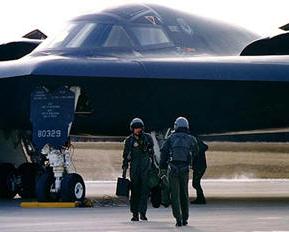|
|||||||||||
|
|
|
|||
|
By |
||||
 |
October 14, 2010 - Northrop Grumman Corporation has begun flight testing the new computing hardware and communications infrastructure that will eventually allow the B-2 stealth bomber to send and receive battlefield information by satellite more than 100 times faster than today.
Since the
beginning of the month, the company has conducted a series of test
flights using a B-2 test aircraft stationed at Edwards Air Force Base,
Northrop Grumman
is the Air Force's prime contractor for the B-2 Spirit, the flagship of
the nation's long range strike arsenal, and one of the world's most
survivable aircraft systems. The B-2 is the only combat-proven stealth
platform in the current |
|||
|
|
||||
|
"The flight test program has demonstrated that the EHF Increment 1 computer upgrade system has reached a maturity level that allows us to conduct test sorties beyond the Edwards AFB local area with confidence," said Ron Naylor, Northrop Grumman's director of the EHF Increment 1 development program. "It also adds momentum to our efforts to give the B-2 the high speed data handling infrastructure it will need for critical communications and weapons delivery upgrades in the future."
Naylor attributes
the success of the test flight program, in part, to the Northrop Grumman
ground crews that helped perform the pre-flight checkout and maintenance
on the B-2 test aircraft.
The EHF Increment
1 system that flew includes a new integrated processing unit developed
by Lockheed Martin Systems Integration, Owego, NY., that will replace up
to a dozen current stand-alone avionics computers on the B-2. A new disk
drive unit developed by Honeywell Defense and Space Electronic Systems, |
||||


